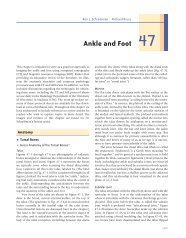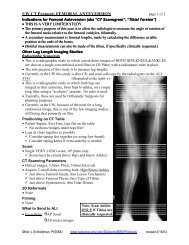CT Protocols: (Brain, ENT, Spine, Vascular) - Department of Radiology
CT Protocols: (Brain, ENT, Spine, Vascular) - Department of Radiology
CT Protocols: (Brain, ENT, Spine, Vascular) - Department of Radiology
Create successful ePaper yourself
Turn your PDF publications into a flip-book with our unique Google optimized e-Paper software.
91 Revised 7/22/09 (Gentry/Ranallo)<br />
Cervical <strong>Spine</strong>: (Adult Routine) (Protocol: # 3.5)<br />
Billing:<br />
Setup:<br />
DFOV:<br />
1. <strong>CT</strong> cervical spine without, or with, or without and with<br />
2. Contrast if used<br />
1. Patient Supine, AP and lateral scouts, no gantry angle<br />
2. Extend the scouts to include the aortic arch for smart prep if IV contrast is to be used.<br />
3. Patient Positioning:<br />
- Warning: Do not flex or extend the neck if there has been recent spine trauma or if<br />
the patient is in a c-spine trauma collar.<br />
- If no recent trauma, tilt the patient’s head so that a line connecting the lateral<br />
canthus <strong>of</strong> the eye and the EAC is perpendicular to the <strong>CT</strong> tabletop.<br />
- The shoulders should be pulled down as much as possible<br />
4. Scan from the top <strong>of</strong> the sella to the bottom <strong>of</strong> T2<br />
Preferred 17 cm (Range 16-18 cm)<br />
Contrast:<br />
1. Injection parameters:<br />
2. Volume: 100 ml <strong>of</strong> 240 mg/ml nonionic contrast (use 150ml <strong>of</strong> 240mg/ml if a <strong>CT</strong> <strong>of</strong> the<br />
head will also be obtained).<br />
3. Injection Rate: Adults: 3.5 ml/sec<br />
4. Smart prep over the aortic arch.<br />
5. <strong>CT</strong> scan delay after arrival <strong>of</strong> contrast in aortic arch: 10 sec (8 slice scanners),<br />
15 sec (16 slice scanners), 20 sec (64 slice scanners)<br />
Recons & Reformats:<br />
1. All 2-D reformats described below are to be done as 2 mm x 2 mm reformats. Do them in the<br />
coronal and sagittal planes.<br />
2. You must include the entire larynx and hyoid bone on the sagittal 2D reformats (see below)<br />
3. If this is an exam solely with contrast or solely without contrast: Do 2D-reformats using both<br />
the standard 1.25 mm images (Recon 1) AND the bone 0.625 mm images (Recon 2)<br />
4. If this is a “with & without” contrast study: Do not do Recons 2 and 3 on the contrast scan.<br />
Do 2D-reformats using the standard 1.25 mm images (Recon 1) only from the contrast series<br />
AND also do 2 mm x 2 mm reformats using the bone 0.625 mm images (Recon 2) from the<br />
non-contrast series.<br />
5. Do not send the 0.625 mm (Recon 2) bone images to PACS.
















